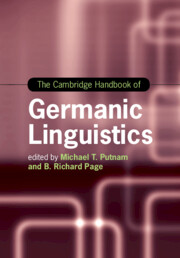Book contents
- The Cambridge Handbook of Germanic Linguistics
- Cambridge Handbooks in Language and Linguistics
- The Cambridge Handbook of Germanic Linguistics
- Copyright page
- Contents
- Figures
- Maps
- Tables
- Contributors
- Acknowledgments
- Germanic Languages
- Part I Phonology
- Part II Morphology and Agreement Systems
- Part III Syntax
- Chapter 15 VO-/OV-Base Ordering
- Chapter 16 The Placement of Finite Verbs
- Chapter 17 Germanic Infinitives
- Chapter 18 The Unification of Object Shift and Object Scrambling
- Chapter 19 Unbounded Dependency Constructions in Germanic
- Chapter 20 The Voice Domain in Germanic
- Chapter 21 Binding
- Chapter 22 Verbal Particles, Results, and Directed Motion
- Chapter 23 Structure of Noun (NP) and Determiner Phrases (DP)
- Part IV Semantics and Pragmatics
- Part V Language Contact and Nonstandard Varieties
- Index
- References
Chapter 16 - The Placement of Finite Verbs
from Part III - Syntax
Published online by Cambridge University Press: 31 March 2020
- The Cambridge Handbook of Germanic Linguistics
- Cambridge Handbooks in Language and Linguistics
- The Cambridge Handbook of Germanic Linguistics
- Copyright page
- Contents
- Figures
- Maps
- Tables
- Contributors
- Acknowledgments
- Germanic Languages
- Part I Phonology
- Part II Morphology and Agreement Systems
- Part III Syntax
- Chapter 15 VO-/OV-Base Ordering
- Chapter 16 The Placement of Finite Verbs
- Chapter 17 Germanic Infinitives
- Chapter 18 The Unification of Object Shift and Object Scrambling
- Chapter 19 Unbounded Dependency Constructions in Germanic
- Chapter 20 The Voice Domain in Germanic
- Chapter 21 Binding
- Chapter 22 Verbal Particles, Results, and Directed Motion
- Chapter 23 Structure of Noun (NP) and Determiner Phrases (DP)
- Part IV Semantics and Pragmatics
- Part V Language Contact and Nonstandard Varieties
- Index
- References
Summary
The chapter gives an overview of the possible positions of finite verbs across the Germanic languages. These possibilities are shown to depend on three independent choices related to three different parts of the clause, CP, TP, and VP:
(1) If the language is a verb second (V2) language, the finite verb in every main clause moves to C°.
(2) If the language has V°-to-T° movement, the finite verb in every clause moves to T° (but if the clause is a V2 clause, then the finite verb will move on from T° to C°).
(3) Finally, depending on whether a language is verb-object (VO) or object-verb (OV), the finite verb in every clause will occur either preceding or following all other elements inside VP, e.g., objects, other complements, adverbials (provided the verb has not undergone movement to T° or to C°).
Keywords
- Type
- Chapter
- Information
- The Cambridge Handbook of Germanic Linguistics , pp. 365 - 388Publisher: Cambridge University PressPrint publication year: 2020
References
- 4
- Cited by

